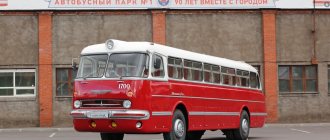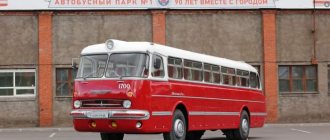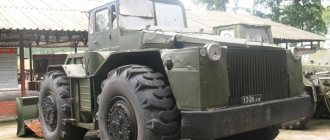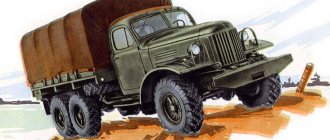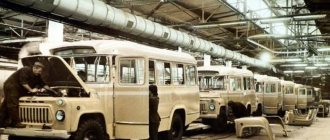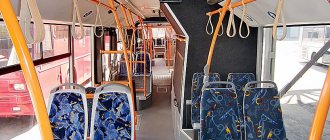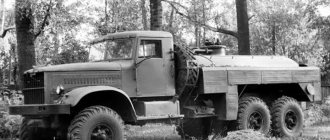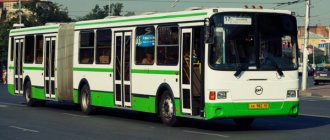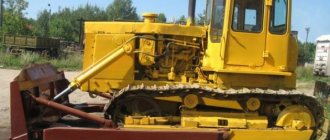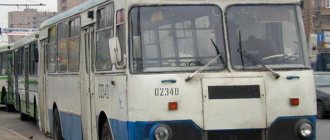Those who remember the articulated Hungarian Ikarus 280 speak about it exclusively in positive terms. Crazy appearance, soft and smooth movement on all types of roads, as well as large capacity - these are the features that passengers paid attention to.
The popular Hungarian “accordion”, which appeared in 1973, made it possible to adapt the presented option to customer requests. When the Ikarus 556 and 180 series began to become obsolete, a new generation came to replace them.
Transport became particularly popular in 1980, when the V Winter Spartakiad was planned in Krasnoyarsk. Then a large batch of buses was purchased. And in 1986, the VI Spartakiad took place and many models needed to be reconstructed. Since then, the fashion for Ikarus began.
These cars became memorable thanks to their carriage-type body with a powerful truss frame. The design resembles a parallelepiped in shape, rounded at the front and with a slightly inclined panoramic glass.
Peculiarities
On Ikarus 280 buses, designed according to the articulated principle, it was possible to combine the number of doors, install different engines and transmissions, and change the length of the vehicle. A two-digit index was used to designate subcategories. For example, the 280.03 variety was a commuter articulated bus with one door in the tractor and trailer, with a four-row interior layout. Model 280.33 is an urban analogue with four doors, a mixed layout and storage. In addition to the 16.5-meter-long version, an extended machine up to 18 m (283) and a single version (260) were produced.
Basic information, characteristics
- Manufacturer/manufacturer where the equipment is produced/manufactured. Ikarus (Ikarus) is a Hungarian bus manufacturing company specializing in the production of city, intercity and special buses. Founded in 1895 as a blacksmith and carriage workshop in Budapest. In the 1980s, it reached an annual production volume of up to 12 thousand cars per year, which placed Ikarus among the largest bus manufacturers in Europe. Currently a small private company.
- Purpose. Urban.
- Class. Especially big.
- Body type. Low-floor articulated carriage layout.
Description
“Ikarus 280” received a carriage-shaped body, erected on a powerful frame truss, covered with panels made of molded steel and aluminum alloy. The outline is an almost regular parallelepiped with a rounded front mask and panoramic windshields placed at a slight angle. This has become a distinctive feature of Hungarian buses. The manufacturer received a number of international prizes for the body design of the 200th line.
The first copies of the conveyor production appeared in 1973. Unlike the well-known Soviet analogs of the LiAZ-677 type, this equipment was equipped with a motor located within the base. This made it possible to optimally distribute the load across the axles. As a result, the floor turned out to be perfectly flat along the entire length of the cabin. At the same time, we had to sacrifice the height of the steps. Access to the power and transmission unit from the cabin has been simplified as much as possible by placing several hatches on the floor.
Advantages and disadvantages
The model was distinguished by its unpretentiousness, good adaptability to difficult natural conditions, high passenger capacity and a convenient interior layout. Employees of operating organizations say that a more reliable, economical and easy-to-use bus has not yet been created. Ikarus is characterized by a high floor , although it is level along its entire length, without steps or ramps, and two steps at the passenger doors, which somewhat slow down the loading and unloading of passengers. This design feature is considered the main disadvantage.
The design of the interior heating system is also considered a drawback . In winter, the interior was heated by two autonomous Sirocco heaters, which actively consumed diesel fuel. In an effort to save fuel, drivers did not turn on the heaters, and the cabin was cold. The weak anti-corrosion treatment of the body can also be considered a disadvantage , although the developers hardly planned for a service life for their cars of more than twenty years, including for this model.
Internal equipment
The covering of the Ikarus 280 bus is made of non-flammable plywood and laminated plastic, the floor is made of fiberboard, covered with a rubber carpet. Entry and exit of passengers is provided by four doors with pneumatic drive. The main advantages of the cabin include good ventilation and a wide passage. However, the car in question was still far from ideal.
Initially, there were complaints that the interior of the Ikarus 280 was cold in winter, and the inside windows were covered with frost. The reason turned out to be banal. Since the autonomous heater was powered by diesel fuel, drivers, trying to save a couple of liters of diesel fuel, periodically turned off the system.
There are only 35 seats inside. The presence of large storage areas made it possible to accommodate up to 160 passengers. The car's cabin is spacious, with a comfortable driver's seat, thoughtful niches and drawers for small items, and hooks for clothes. The dashboard has large traditional instruments - a tachometer and a speedometer.
The steering wheel is equipped with a hydraulic booster, the clutch unit is equipped with a pneumatic “assistant”. The equipment in question is distinguished by a light transmission pedal and an informative gear lever. The drive rod is a shaft, the thickness of which is comparable to the cardan equivalent of a passenger car. This margin of safety made it possible to withstand almost any critical load.
Comfortable movement
Throughout its existence, Ikarus 280 has been able to withstand any, even particularly critical, loads due to the drive shaft. This is like a gimbal analogue in any passenger car, which acted as a traction device.
Despite its large dimensions, the bus was quite controllable and maneuverable. Good smoothness was ensured by air suspension on cylinders. The 5-speed gearbox created additional stability on roads with different inclination angles.
The bus does not have stabilizers to create lateral stability. But bypass valves work in such a way that they redistribute the air and allow you to avoid leaning during a turn. The valves are connected to the body by adjustable reaction rods, but there are no bridges.
The brake system with a drum system and a pneumatic drive is specially “sharpened” as follows. If there is no air pressure in the system, the parking brake drive cannot be unlocked.
The suburban version of the bus did not travel fast in those days. About 65 km/h on average, but consumed decently - 33 liters per 100 kilometers. However, drivers still respected the model for its reliability and structural strength, as well as for its main function - driving.
If you do the calculations, you can imagine that at a speed of 60 km/h the braking distance will be 31.3 meters. And this is with a bus length of 16.5 meters and a total weight of 12.5 tons. This once again speaks of the soft and smooth movement of Ikarus.
Suspension unit
This element is no less interesting than the other nodes. “Ikarus 280” was equipped with pneumatic cylinders on each bridge, which ensured a good smooth ride. Instead of anti-roll bars, the designers used bypass valves connected to the body part via adjustable reaction rods with autonomous silent blocks. When distributing air, they helped level out rolls when turning, but they needed to fix the bridges to prevent them from moving.
Torque force was transmitted from the power unit to the middle drive axle through a central and a pair of wheel gearboxes. This scheme made it possible to correctly distribute the load on the axle shafts and change the gear ratio in the gearbox, depending on the modification of the vehicle.
Testing Ikarus-293 on the streets of Tehran
0
Source:
Since the extra-long bus could not be transported by rail or truck, the Ikarus headed to Iran under its own power (!) - through Yugoslavia, Bulgaria and Turkey. Upon arrival in Iran, Ikarus-293 was tested on the streets of Tehran for the first six months. He carried passengers along a seven-kilometer route, in shifts of seven hours a day, and serving about three thousand passengers per shift. After six months of testing in Tehran, the customer wanted to purchase some more three-section “accordions” - but they never received a solid order from the Middle East in Hungary.
Engine "Ikarus 280"
The power plant is located under the floor of the passenger section. The engine is a six-cylinder diesel engine of the Raba-MAN D2156 HM6U type. Its brief parameters:
- Working volume – 10.35 l.
- Power indicator – 190 horsepower.
- Torque – 710 Nm.
- The location of the cylinder block is horizontal. Thanks to this solution, the unit turned out to be compact, which had a positive effect on reducing the center of gravity, making the equipment resistant to tipping.
The ASH 75.2-A8 five-speed manual transmission interacts with the engine. The engine service life before major overhaul is impressive, provided proper maintenance and appropriate care. The average figure in this regard is at least half a million kilometers. Timely capitalization extended the life of the part by another 150 thousand.
Ikarus-260.71 on the streets of Tehran, 2008
0
Source:
In 1991, the Hungarians signed an agreement with an Iranian customer for a large supply of Ikarus buses. It was planned that Ikarus would build 2,100 single and 900 articulated buses for Iran, which were supposed to arrive from August 1991 in time for the start of the school year. The total contract amount, including the cost of supplied spare parts, exceeded $290 million. However, later Iran, squeezed by Western economic sanctions, was able to pay for only 1,300 buses - and until relatively recently, on the streets of Tehran, Russian tourists marveled at the almost familiar, albeit very tired, Hungarian “accordion” model 280.
Performance characteristics in numbers
Below are the technical characteristics of the Ikarus 280:
- Dimensions – 16.5/2.5/3.16 m.
- Capacity – 168 people.
- The body is of an all-metal load-bearing type.
- The power unit is a Raba four-stroke diesel engine.
- Compression – 17.
- The maximum power indicator is 192 hp. With.
- Speed – 66.5 km/h.
- Base – 5.4/6.2 m.
- Front/middle/rear wheel track – 2.0/1.83/2.0 m.
- Turning radius – 10.5 m.
- Ground clearance – 35 cm.
- Fuel tank capacity – 250 l.
- Curb weight – 12.54 tons.
- The approach angle is 17.2 percent.
Ikarus-293 in the second iteration - after reconstruction at the factory. 1991, factory photo
0
Source:
When the smell of delicious orders from the Middle East began to smell, the “super accordion” 293 was remembered again - and in 1991, the existing prototype was reconstructed for an Iranian customer, having carried out a kind of work on the mistakes. The place of the ancient Raba diesel engine was taken by the modern MAN D2866 TUH01 turbodiesel with six cylinders and 280 hp. The gearbox, a Voith automatic, remained the same when the prototype was rebuilt. In order to accommodate the non-standard engine for the Ikarus, the doors had to be rearranged: the second door of the tractor was moved forward, closer to the steering axis. However, this solution is well known even in cars for Russia: this was also done on the exotic versions “280” and “283” with Western engines from MAN, Mercedes and Renault, which were not originally intended for installation under the floor of a city bus. For example, many similar Ikarus with displaced doors were and remain on the routes of Yekaterinburg. Also, during the reconstruction, the interior layout was somewhat revised, taking into account the needs of the Middle Eastern customer. The final touch of the reconstruction was the repainting: from the strict blue-gray Budapest livery to a bright yellow-pink color. In this form the car went to Iran.
Delivery to the USSR
It supplied several modifications to the Soviet Union. In 1984, version 02 was replaced by version 33. It was equipped with a six-speed manual transmission. The salon has also undergone a number of changes. The color of the handrails changed from white to black, and the narrow windows were replaced with tall half-window counterparts. Later models were equipped with turbine supercharging.
In 1989, deliveries of buses with the index “64” began. They differed from their predecessors by modernized planetary doors with two leaves. New seats, flat fluorescent lamps and an updated driver's partition were installed in the cabin.
In the early 90s, the outdated D2156 engine was replaced with a more modern version of the D10, also produced in the city of Rab under license from MAN. The new engine of the Ikarus 280 is a 10.35-liter diesel engine with a capacity of 210 horsepower. Depending on the variation, it complied with Euro 1 or 2 standards. Since the design of the power plant has undergone significant changes, the layout of the engine compartment had to be changed. The system now includes pressure-type nozzles. The power steering and compressor were reinstalled from the left side to the right side of the unit.
Hungarian “accordion”: what we will remember Ikarus 280 for
Prerequisites for the appearance
At the end of the 60s, the Ikarus 556/Ikarus 180 family of city buses began to slowly but surely become obsolete.
To replace them, designers at the Szekesfehérvár plant began developing a new generation of machines. The main innovation of the 200 series was the modular design, which made it possible to create a lot of modifications to suit any consumer needs. Buses built according to this principle made it possible to combine the number of doors, change the length, and vary the engines and gearboxes. As a result, to designate a sub-modification equipped with a different engine or interior design, it was necessary to add a two-digit index. Thus, Ikarus-280.03 is a commuter articulated bus with a four-row interior layout and one door in the trailer and tractor, and modification 280.33 is a city bus with four doors, a drive and a mixed layout. In addition to the 16.5-meter version, there was a version extended to 18 meters with the index 283, as well as a single machine, which received the index 260.
Pictured: Ikarus 280 '1971–2003
The carriage-type body, built on a powerful truss frame and covered with molded steel and duralumin panels, was almost a regular parallelepiped in shape, only rounded by the front mask and slightly inclined panoramic windshields. But this is precisely what made the Ikarus so memorable - it is simply impossible to confuse them with other buses. For its body, the 200th family received the silver cup of the Prince of Monaco, as well as a gold diploma from the Leipzig Fair and a silver cup from the French Association of Coach Houses.
The first production buses rolled off the assembly line in 1973. Unlike Soviet buses, the most modern representative of which was the LiAZ-677 , already known to us, the Hungarian cars had an engine located within the base, which made it possible to achieve optimal load distribution between the axles and, as a result, an absolutely flat floor along the entire length of the cabin - true , I had to sacrifice the height of the steps. But access to the engine and gearbox from the cabin is simplified as much as possible - for this purpose, several large hatches are located in the cabin floor.
One minus:
Convenience for repairmen subsequently led to a lot of problems for passengers. Over the years, the seals on the hatches wore out, and coupled with the condition of the engine and poor maintenance, this led to exhaust fumes entering the cabin, turning the trip into an ordeal.
The interior lining of the bus was made of fire-resistant plywood and laminated plastic, and the floor made of wood boards was covered with a rubber carpet. The necessary rotation of passengers was ensured by four screen doors with a pneumatic drive. The main advantages of the passenger compartment were good ventilation and a wide passage, but, as you know, there are no ideal cars.
1 / 2
2 / 2
Passengers have complained from the very beginning that it is cold in Hungarian buses in winter, and the windows on the inside are covered with frost. The reason for this fact was simple: the design of the bus used an autonomous heater powered by diesel fuel and connected to the engine cooling system. By the way, along with the main functions of heating the interior, it also served as a pre-heater. As a result, drivers, in an attempt to save a few liters of diesel fuel, often simply turned off the system during the day.
Pictured: Ikarus 280 '1971–2003
In total, there were only 35 seats in the cabin, which, coupled with large storage areas, provided accommodation for up to 160 passengers. The cabin of the bus matched the interior - it was more spacious in comparison with its Soviet counterparts, it had a comfortable driver's seat, thoughtful places for small things and several hooks for clothes, as well as the usual speedometer and tachometer. In addition, the steering wheel had a powerful hydraulic booster; The clutch also had its own pneumatic booster. Ikarus were famous among drivers for their light clutch pedal and precise gearbox linkage - and this is not surprising, because the drive for gear shifting was a shaft as thick as the cardan of another passenger car, the strength of which made it possible to withstand any abuse.
Articles / History Not only Ikarus: the Hungarian auto industry during socialism There is an opinion that in Hungary, with the exception of the well-known Ikarus, there was no auto industry of its own. But this is not so: the automotive industry of this country has a hundred-year history! 26861 5 14 04/01/2016
The suspension of the bus was no less interesting. Each bus axle was suspended on pneumatic cylinders, which helped to achieve a good smooth ride. There were no anti-roll bars on the bus: instead, the engineers used bypass valves connected to the body by special adjustable torque rods with their own silent blocks. By redistributing air, they helped to avoid roll in corners, but required fixing of the axles to prevent displacement.
Torque from the engine was transmitted to the middle drive axle, which consisted of a central and two wheel gearboxes. Such a scheme made it possible to more competently distribute the load from the engine on the axle shafts, and the use of a wheel drive made it possible to change the gear ratio in the gearbox for various modifications of buses.
The brake system with drum brakes and pneumatic drive was designed in such a way that if there was no air pressure in the circuit, the parking brake could not be released. With the engine running, the compressor quickly pumped the required pressure into the receivers located almost under the driver’s workplace. From a speed of 60 km/h, the braking distance of a 16.5-meter bus with a curb weight of 12.5 tons was only 31.3 meters.
Official supplier for the Soviet Union
The supply of accordions to the Union was opened back in 1973 by Ikarus-280.01. The buses were painted in the traditional USSR orange color and featured small quarter-window windows, and the interior had white handrails and trim in light colors. The driver got his own partition in the front door, separating the cabin from the passenger compartment.
In the photo: Ikarus 280
Under the floor of the passenger compartment there is an in-line 6-cylinder diesel engine Raba-MAN D2156 HM6U. The engine with a displacement of 10.35 liters had a combined lubrication system and developed 190 hp. and 710 Nm of torque. The cylinder block was positioned horizontally, making the engine very compact, which had a positive effect on lowering the center of gravity and made the Ikarus resistant to rollover. The engine was paired with a 5-speed manual transmission ASH 75.2-A8. The service life of the Hungarian diesel engine with proper care was very high - before a major overhaul, the Raba had to run half a million kilometers, and a major overhaul carried out on time extended the life of the engine by another 150 thousand.
Interesting fact:
The Hungarians tried to respect copyright and did not hide the origin of components and assemblies. For example, on the gearbox produced by the Csepel there was a sign “manufactured under license from ZF”; there was a similar one on the engine manufactured under license from MAN.
From Hungary, along with the buses, came sets of special tools designed to perform repairs and maintenance of buses. Our transport workers have never seen anything like this! To train mechanics, plant specialists provided detailed manuals on operation and maintenance. Moreover, these could be not only brochures or posters, but even classrooms, where components and assemblies were installed “in section.”
In the photo: interior of Ikarus 280
In 1984, modification 01 was replaced by 33, which introduced a new 6-speed manual transmission ZF S6-90. The changes also affected the interior - the color of the handrails changed to a less easily soiled black, and the narrow windows were replaced by tall windows the size of half a window. A little later, to increase power, bus engines began to be equipped with turbocharging.
Articles / Lunokhod bus No. 677: the history of the creation of the LiAZ-677 bus This bus has become one of the symbols of public transport of the former USSR - few people are not familiar with this big, pop-eyed beast. Now many people know about its technical features, like the car... 92619 1 66 06/12/2016
In 1989, modifications with the index “64” began to be supplied to the Union, which differed from their predecessors in more modern double-leaf planetary doors. The interior has new seats, flat luminescent lamps and a different driver's cabin partition.
In the early 90s, the outdated D2156 engine was replaced with a more modern one with the D10 index, also produced at the plant in the city of Raba under license from MAN. Like the D2156, it was a 210-horsepower horizontal turbocharged diesel engine, the displacement of which was the same 10.35 liters. Depending on the modification, it could meet Euro-1 or Euro-2 environmental standards. The design of the engine has undergone significant changes, which is why it was necessary to change the layout of the engine compartment. New pump injectors appeared, produced under license from Bosch, the power steering and compressor were moved from the left to the right side of the engine.
A city bus that sits in traffic jams for a long time, and often accelerates and stops, required a more powerful cooling system: the fan was made electric, and the surface area of the radiator was increased by almost one and a half times. The six-speed gearbox remained the same, but a new clutch with a petal-type basket was developed for the new engine. In the late 90s, the Raba axles were modernized, and the location of the oil filler necks was also changed.
In the photo: Ikarus 280
Life after the breakup
For two decades, the Ikarus-280 turned out to be the only large-capacity bus supplied to the Soviet Union, capable of handling the passenger traffic of large cities. In the late 80s, in large cities, “accordions” extended to 18 meters in length with the index “283” began flying. Due to the increased load on the trailer axle, it had to be made gable, thereby eliminating the rotation of the rear wheels, which immediately affected maneuverability for the worse. Later, buses of the “four hundredth” series were supplied to the markets of large Russian cities - with a lower floor level and an engine in a trailer.
In the photo: Ikarus 283
The “280th” itself outlived both the “283rd” and the more modern Ikarus-435. After the collapse of the USSR, direct deliveries of Hungarian buses were reduced - not every city was ready to pay a substantial amount for Ikaruses, which became full-fledged foreign cars. And if the supply of single Ikarus-260 could be somehow compensated for by the LiAZ-5256 produced, then Russia no longer had its own “accordion”.
In the photo: Ikarus 435
Of course, attempts to launch the production of articulated vehicles were made by many domestic enterprises. Their “joint members” were offered, for example, by GolAZ, which mastered the production of licensed copies of Mercedes O405 buses under its own name “Russian” in Golitsyno, near Moscow, and Alterna, which produced very simple buses of its own design. But prices for models and production volumes did not meet the demands of cities.
1 / 2
2 / 2
Motor transport enterprises began to look for a way out on their own. Both single and articulated used Ikarus, Mercedes, MAN, Volvo buses were purchased from Eastern European countries and Germany. In 1993, screwdriver assembly of Ikarus-280 began at the facilities of the Tushinsky Machine-Building Plant, which largely satisfied Moscow’s needs for this type of bus. Buses arrived from Hungary under their own power, and seats and interior trim were installed in Tushino.
Later, the “accordions” were assembled at the Kurgan Bus Plant, mainly for deliveries to Yekaterinburg. A small number of buses for Minsk were assembled by the Belarusian industrial holding Amkodor. Production of Ikarus 200 series ceased in 2001 along with the closure of the plant itself.
We don't say goodbye
Despite the end of production, 2001, of course, did not mark the disappearance of “accordions” with Hungarian roots from city streets. Moreover, somewhere they smoke the sky even today - most often in the literal sense, aged, dilapidated and living out their days in small bus depots. But we will forever remember the ingenuous look of their round headlights in “black glasses”, their smooth ride and diligent rattling. Or maybe we will even find one in the reserve of passenger vehicles and tell you about it in even more detail - after all, we found its brother, Ikarus 256 . And therefore, even having forgotten what the streets with orange “accordions” looked like decades ago, we do not say goodbye to them.
In the photo: Prototype of the Ikarus-280 trolleybus
Survey
What are your memories of the Ikarus 280?
Your voice
Total votes:
Life after perestroika
For 20 years, the Hungarian car was the only large-capacity bus designed for the huge passenger traffic of large cities. At the end of the 80s, Ikarus 280, whose length was 18 meters, went on flights. Since the accordion increased the load on the trailer axle, it was made of a gable type, preventing the rear wheels from turning. This negatively affected maneuverability. A little later, modifications of the “400” series appeared on the market, which were equipped with a motor in the trailer and had a lower floor level.
The lineup
The modular design of vehicles has made it possible to develop buses with different numbers of doors and design lengths. However, the technical specifications still remained similar.
Both 8-meter miniature cars and full-fledged 18-meter ones were produced. For example, a small car was produced with the index 260, and a long model up to 18 meters was marked 283. The model range also differed in the number of windows and the size of the vents, as well as the gearbox.
Throughout the history of production, Ikarus 280 buses have been equipped with different engines. These were the famous brands MAN, KAMAZ, YaMZ, Cummins and others. Surprisingly, the engine was located horizontally. It was located under the passenger compartment, namely under the floor. Access to the transmission was easy due to the installed hatches.
The 280.03 series is a full-fledged commuter look with doors, one installed in the tractor and the other in the trailer. Interestingly, there is a four-row seating arrangement in the cabin.
Urban Ikaruses marked 280.33M with a powerful non-toxic engine from the manufacturer RABA-MAN were also produced. This is a model with up to four doors, a mixed layout and storage.
By the way, about color. For the USSR, buses were painted exclusively yellow. In Bulgaria, Czechoslovakia and Poland they were red, and in Berlin they were white and orange. White and red people met in Budapest. By the way, in 2004, a businessman from Krasnoyarsk purchased a blue model, which was later repainted white by the new owner.
Separately, it is worth noting that the transport delivered to the Union was distinguished by quarter-window windows and white handrails with light trim in the interior. The driver had his own partition that separated the interior and cabin.
Forced competition
"Ikarus 280" survived the 283rd and 435th variants. After the collapse of the Soviet Union, not every city could afford to purchase a Hungarian car, which became a full-fledged “foreign car”. Single models of the 260 series partially compensated for the LiAZ-5256, but there was no “accordion” of its own in the post-Soviet space.
Attempts were made to manufacture similar analogues at GolAZ, in Yekaterinburg, and Tushino. As a rule, they got out of the situation by purchasing single and articulated buses of foreign production that were used.
Surprisingly, the bus is still alive!
0
Source:
Let me introduce: a three-section bi-articulated bus Ikarus-293.K1. Model 293 was in many ways “the very best”: the length of the car was a record for Ikarus 22.7 meters, and the total passenger capacity of Ikarus-293 was no less than a record 229 people. After many years of obscurity, the bus was found safe and sound in the capital of Iran, Tehran. The unique “Ikarus” was considered lost, but not forgotten - after all, the “293” model was a kind of pinnacle of the evolution of the Hungarian “accordion”. Modern photographs of the car were published on Instagram by an Iranian enthusiast named Reza Ahmadi. However, first things first – let’s start with the history of the model.
×
Interesting Facts
The accordion bus had a design that provided repairmen with free access to most units. This moment had a negative impact on passengers. Over time, the seals on the hatches wore out, the engines were not always properly maintained, and they began to smoke. As a result, exhaust gases entered the cabin, turning a comfortable trip into a real test.
Hungarian manufacturers did not hide the origin of the parts and components used. For example, there was a sign on the power unit indicating that the motor was manufactured under license. A similar sign, only from the Csepel plant, was present on the gearbox.
Along with the machines, sets of special tools for repair and maintenance of equipment were supplied from Hungary. To train repairmen, the plant's designers provided detailed instructions, including manuals with cross-sectional images of units and components.
The Ikarus 280 city bus, whose articulation did not allow for sharp maneuvers, required an improved cooling system. In addition, this parameter was also affected by frequent stops and accelerations. As a result, the car was equipped with an electric fan, and the surface of the radiator was increased by almost one and a half times. The six-mode manual transmission remains the same. A clutch with a petal basket was specially developed for the new engine. In the late nineties, the Raba axles were improved and the placement of the oil filler necks was changed.
After the collapse of the Union, “accordions” were also assembled at the Kurgan Bus Plant. The main supply market is Yekaterinburg. For Minsk, a limited series of buses of this type was assembled by the Belarusian holding Amkodor.
Serial production of Hungarian accordions of the 200 series ceased in 2001 due to the closure of the manufacturing plant.
Gifts of the fraternal republics
When starting a conversation about Polish cars on Soviet roads, we have already talked about such a milestone in world history as the creation of the Union for Mutual Economic Assistance. So, the supply of Hungarian buses is another result of the CMEA’s work. Our country really needed especially large-capacity buses, or OBVs for short—passenger traffic in cities was growing. And the articulated Ikarus were just what the doctor ordered. If an ordinary bus could accommodate up to a hundred passengers (usually 80-90 - both seated and standing, when calculating the load at rush hour - 8 people per m2), then it could carry as many as 180 people. For such abilities, the buses were popularly called “cattle carriers.” In good times, the Hungarian plant produced 14,000 buses a year. They were distributed all over the world - in addition to the CMEA countries, they also went to the countries of Africa, Scandinavia, were made jointly in the USA, Canada, the DPRK, and were assembled in Cuba under the Chiron brand. We got the most: over half a century of cooperation, the Ikarus plant supplied more than 150,000 buses of various models to the USSR and Russia. In 1985, newspapers wrote that 95% of the plant’s production goes to the Union, and 25% of the bus fleet of the RSFSR consists of vehicles of this brand.
Color options for buses in different countries
It must be said that the history of the Hungarian automobile plant began much earlier than the “fraternization” of the republics. At the very end of the 19th century, the carriage workshop of the Uri brothers appeared in Budapest. Then it produced bus bodies, repaired automobile equipment and even produced airplanes. The name “Ikarus” appeared after World War II - when the company was nationalized and merged with the joint-stock company of the same name. It refers to the mythical Icarus, as does the name of the bus.
In total, the plant created more than 30 bus models. They began to be delivered to us in 1955: then 20 buses of the “55” brand arrived. The predecessor of our today's hero is the Ikarus 180, an articulated bus created on the basis of the Ikarus 556. They have been produced since 1966. And since 1973, it was replaced by the more modern Ikarus 280.
“In the second half of the 1960s, Ikarus 180 were massively supplied to the Soviet Union. They also worked in Krasnoyarsk - somewhere until the end of the 1970s. At this time, they began to be actively replaced by the new 200 series: single 260s and articulated 280s. In terms of units and layout, these were similar cars, but still the 280s were more modern. The Ikarus 280 had greater capacity, the engine was modified and became more powerful. The design has also changed: the 180 has rounded shapes, and the 280 is angular - in the spirit of the 1970s,” says Ilya Lopin, administrator of the Auto-Retro club.
Consumer Opinion
Reviews about the Ikarus 280 are mostly positive, both from passengers and drivers. Those who remember these articulated beauties talk about their original external design, smooth movement even on uneven roads and large capacity, which was vital during rush hours. Among the shortcomings, consumers note a small number of seats, poor heating in winter and a burning smell in the cabin.
Drivers, first of all, appreciate a comfortable working seat, good visibility, and an informative dashboard. Experts also note easy access to most of the main components directly from the cabin. The advantages include simplicity and information content of controls, clutch pedals, and reliability of brakes.
Operator reviews
For ease of maintenance of the bus, it is very important that access to the gearbox and engine is possible through hinged covers on the left side and special technical hatches in the floor of the cabin.
A manual transmission may be an outdated technical solution, but in conditions of urban winter (in Russia at least four months a year), icing and compacted snow, it is the only thing that helps the driver in a low gear to take a heavy car up a slippery slope. Ikarus drivers praise the clutch pedal and the convenient gear shift mechanism, which works very accurately, since in this model the gear shift drive rod is a powerful shaft, and not cables, as in later models.
The large distance between the side handrail on the turntable and the accordion bellows casing forced the driver to frequently retrieve fallen belongings of passengers by lifting the turntable cover at stops.
Passengers always complained about the cold on buses in winter, but this was not so much a question of the design of the heating system as of fuel economy. Repairers believe that in the new editions of the Ikarus 280 the stoves heat poorly due to design flaws, because the second thermostat, which is installed behind the front panel cladding, passes liquid from the cooling system to the stoves with a delay.
Let's summarize
Despite the fact that production of the Ikarus 280 bus ended in 2001, “accordions” have not yet completely disappeared from our streets. Of course, there are very few of them; almost all of them are worn out and dilapidated, living out their days with dignity. It is worth noting that the Hungarian vehicle at one time was a real decoration of Soviet roads, solving pressing problems of transporting a large number of passengers in large and medium-sized cities. Many examples of the 280s and other series of Ikarus are presented in various automobile museums around the world.
Further fate
Somewhere after 1990, the RABA-MAN engine stopped being supplied to Russia. Products from the Altai Motor Plant were adapted and soon the Ikarus became even more powerful. But the model was successfully produced by the plant until 2001. Afterwards the plant went bankrupt.
The most interesting thing is that the Ikarus continued to drive in different cities, but in Krasnoyarsk it broke down. Recently, their rear parts have been welded to other tractors. In 2009, the last “accordion” had its trailer cut off. According to official data, articulated buses of this series stopped operating in 2011.
Driver's workplace
The cabin of the accordion bus was much more spacious than that of conventional cars; it was completely separated from the passenger compartment. The well-thought-out shape of the driver's seat and a comfortable tilt angle contributed to the creation of a comfortable working environment. In the free access area there was a dashboard with all controls, in the usual place - a tachometer and speedometer.
Useful: New Scania truck for a transport company
The ease of driving was facilitated by an adjustable steering column with its own power steering. The high seat offered a wide viewing angle. The cabin also had niches and shelves for storing small items and hooks for clothes.
Modernization
Starting from 1973, Ikarus 280.01 was supplied to the USSR.
In 1984 it was replaced by version 280.33. The modification remained almost unchanged in appearance, except that the windows were now installed high, and the color of the handrails in the cabin became black. But technically the model was seriously modernized:
